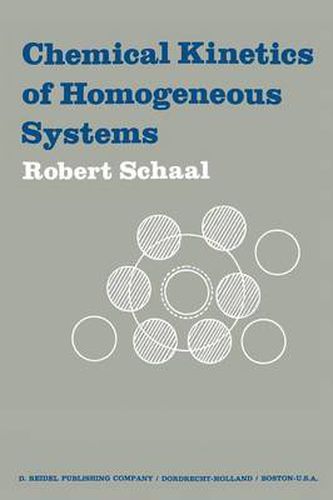Readings Newsletter
Become a Readings Member to make your shopping experience even easier.
Sign in or sign up for free!
You’re not far away from qualifying for FREE standard shipping within Australia
You’ve qualified for FREE standard shipping within Australia
The cart is loading…






This title is printed to order. This book may have been self-published. If so, we cannot guarantee the quality of the content. In the main most books will have gone through the editing process however some may not. We therefore suggest that you be aware of this before ordering this book. If in doubt check either the author or publisher’s details as we are unable to accept any returns unless they are faulty. Please contact us if you have any questions.
Chemical kinetics aims to explain the factors governing the change with time of chemical systems. The results enable one to define optimum technico-economic condi tions (such as the choice of batch or continuous processes; of concentration, temperature, and pressure; of whether to use a catalyst) for the preparation of products, so that kinetics is intimately bound up with many processes of chemical industry (production, explosions, combustion, propulsion in air and in space). On another level, kinetic studies are indispensable for understanding reaction mechanisms, which implies a de tailed knowledge of the different chemical intermediates (possibly very transitory) of a chemical reaction. But in practice it is rarely possible to work with microscopic quantities of reagents and, with the exception of crossed molecular beams, all methods give only statistical results concerning a large number of molecules. Because of this restriction, it has not always been possible to establish conclusively a reaction mechanism, even for reactions ap parently simple. Numerous attempts have been made to calculate rate constants from the physical properties of the participating molecules; but the introduction of the ‘time’ factor into calculations of the distribution of energies of chemical processes makes this very difficult, so that the elucidation of mechanisms still depends almost entirely on experi mental studies. However, several theories have been elab orated which, in giving a more and more precise picture of the reaction process, have proved very fruitful, and have become indispensable in designing experiments.
$9.00 standard shipping within Australia
FREE standard shipping within Australia for orders over $100.00
Express & International shipping calculated at checkout
This title is printed to order. This book may have been self-published. If so, we cannot guarantee the quality of the content. In the main most books will have gone through the editing process however some may not. We therefore suggest that you be aware of this before ordering this book. If in doubt check either the author or publisher’s details as we are unable to accept any returns unless they are faulty. Please contact us if you have any questions.
Chemical kinetics aims to explain the factors governing the change with time of chemical systems. The results enable one to define optimum technico-economic condi tions (such as the choice of batch or continuous processes; of concentration, temperature, and pressure; of whether to use a catalyst) for the preparation of products, so that kinetics is intimately bound up with many processes of chemical industry (production, explosions, combustion, propulsion in air and in space). On another level, kinetic studies are indispensable for understanding reaction mechanisms, which implies a de tailed knowledge of the different chemical intermediates (possibly very transitory) of a chemical reaction. But in practice it is rarely possible to work with microscopic quantities of reagents and, with the exception of crossed molecular beams, all methods give only statistical results concerning a large number of molecules. Because of this restriction, it has not always been possible to establish conclusively a reaction mechanism, even for reactions ap parently simple. Numerous attempts have been made to calculate rate constants from the physical properties of the participating molecules; but the introduction of the ‘time’ factor into calculations of the distribution of energies of chemical processes makes this very difficult, so that the elucidation of mechanisms still depends almost entirely on experi mental studies. However, several theories have been elab orated which, in giving a more and more precise picture of the reaction process, have proved very fruitful, and have become indispensable in designing experiments.